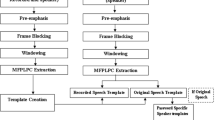Abstract
This work presents the development of a multi-level speech based person authentication system with attendance as an application. The multi-level system consists of three different modules of speaker verification, namely voice-password, text-dependent and text-independent speaker verification. The three speaker verification modules are combined in a sequential manner to develop a multi-level framework which is ported over a telephone network through interactive voice response (IVR) system for aiding remote authentication. The users call from a fixed set of mobile handsets to verify their claim against their respective models, which is then authenticated in a multi-level mode using the above stated three modules. An analysis over a period of two months is shown on the performance of the multi-level system in attendance marking. The multi-level framework having combination of the three modules helps in achieving better performance than that of the individual modules, which shows its potential for practical deployment.







Similar content being viewed by others
Notes
An initial version of this work with text-independent speaker verification system framework is presented at the National Conference on Communication in February 2014. [21]
References
“The NIST Year 2010 Speaker Recognition Evaluation Plan”, NIST, (2010).
“The NIST Year 2012 Speaker Recognition Evaluation Plan”, NIST, (2012).
Hatch, A O, Kajarekar, S, & Stolcke, A (2006). Within-class covariance norMalization for svm-based speaker recognition. In Proc. of ICSLP, pp. 1471–1474.
Jain, A K, Ross, A, & Prabhakar, S (2004). An introduction to biometric recognition. IEEE Trans Circuits Syst Video Technol, 14(1), 4–20.
Larcher, A, Lee, K A, Ma, B, & Li, H (2014). Text-dependent speaker verification: classifiers, databases and RSR2015. Speech Comm, 60, 56–77.
Ross, A, & Jain, A K (2014). Multimodal biometrics: an overview. In 12th European IEEE Signal Processing Conference, 1221–1224.
Putra, B (2011). Suyanto: Implementation of secure speaker verification at web login page using mel frequency cepstral coefficient-gaussian mixture model (mfcc-gmm). In Instrumentation control and automation (ICA), 2011 2nd international conference on, pp. 358–363.
Atal, B S (1976). Automatic recognition of speakers from their voices. Proc IEEE, 64(4), 460–475.
Chakrabarty, D, Prasanna, M S R, & Das, R K (2013). Development and evaluation of online text-independent speaker verification system for remote person authentication. Int J Speech Technol, 16(1), 75–88.
Reynolds, D A, Thomas, F Q, & Dunn, R B (2000). Speaker verification using adapted Gaussian mixture models. Digital Signal Process, 10(1-3), 19–41.
Sarkar, G, & Saha, G (2010). Real time implementation of speaker identification system with frame picking algorithm. Procedia Computer Science, 2(0), 173–180. Proc. of the Int. Conference and Exhibition on Biometrics Technology.
Lee, K -A, Larcher, A, Thai, H, Ma, B, & Li, H (2011). Joint application of speech and speaker recognition for automation and security in smart home. In INTERSPEECH, pp. 3317–3318.
Muda, L, Begam, M, & Elamvazuthi, I (2010). Voice recognition algorithms using mel frequency cepstral coefficient (mfcc) and dynamic time warping (dtw) techniques. CoRR, 2151–9617.
Hébert, M (2008). Text-dependent speaker recognition. In J. benesty, M. Sondhi, Y. Huang (eds.) Springer Handbook of Speech Processing, pp. 743-762. Springer Berlin Heidelberg.
Dehak, N, Kenny, P J, Dehak, R, Dumouchel, P, & Ouellet, P (2011). Front-end factor analysis for speaker verification. IEEE Trans Audio Speech Lang Process, 19(4), 788–798.
Auckenthaler, R, Carey, M, & Thomas, H L (2000). Score norMalization for text-independent speaker verification systems. Digital Signal Process, 10(1–3), 42–54.
Duda, R O, Hart, P E, & Stork, D G. (2000). Pattern Classification: John Wiley and Sons.
Ramos-Lara, R, Lpez-Garca, M, Cant-Navarro, E, & Puente-Rodriguez, L (2013). Real-time speaker verification system implemented on reconfigurable hardware. Journal of Signal Processing Systems, 71(2), 89–103.
Rao, S, & Satoa, K J (2013). An attendance monitoring system using biometrics authentication. International Journal of Advanced Research in Computer Science and Software Engineering, 3(4).
Bolle, Ruud, & Pankanti, Sharath. (1998). Biometrics, personal identification in networked society: Personal identification in networked society. norwell, MA, USA: Kluwer academic publishers.
Dey, S, Barman, S, Bhukya, R K, Das, R K, Haris, B C, Mahadeva Prasanna, S R, & Sinha, R (2014). Speech biometric based attendance system. In National conference on communications.
Furui, S (1981). Cepstral analysis technique for automatic speaker verification. IEEE Trans Acoust Speech Signal Process, 29(2), 254–272.
Sahoo, S K, Choubisa, T, & Mahadeva Prasanna, S R (2012). Multimodal biometric person authentication : a review. IETE Tech Rev, 29(1), 54–75.
Nawas, T, Pervaiz, S, Korrani, A, & Azhar-ud-din (2009). Development of academic attendence monitoring system using fingerprint identification. International Journal of Computer Science and Network Security, 9(5).
Kinnunen, Tomi, & Li, Haizhou (2010). An overview of text-independent speaker recognition: From features to supervectors. Speech Comm, 52(1), 12–40.
Fisher, W M, Doddington, G R, & Goudie-Marshall, K M (1986). The DARPA Speech Recognition Research Database: Specifications and Status. In Proceedings of DARPA workshop on speech recognition, pp. 93–99.
Kawaguchi, Y, Shoji, T, Lin, W, Kakusho, K, & Minoh, M (2009). Face recognition-based lecture attendance system. Department of Intelligence Science and Technology, Graduate School of Informatics Kyoto University.
Author information
Authors and Affiliations
Corresponding author
Additional information
This work is supported by the project grant no. 12(6)/2012-ESD from the e-security division of Department of Electronics & Information Technology (DeitY), Govt. of India
Rights and permissions
About this article
Cite this article
Das, R.K., Jelil, S. & Mahadeva Prasanna, S.R. Development of Multi-Level Speech based Person Authentication System. J Sign Process Syst 88, 259–271 (2017). https://doi.org/10.1007/s11265-016-1148-z
Received:
Revised:
Accepted:
Published:
Issue Date:
DOI: https://doi.org/10.1007/s11265-016-1148-z




